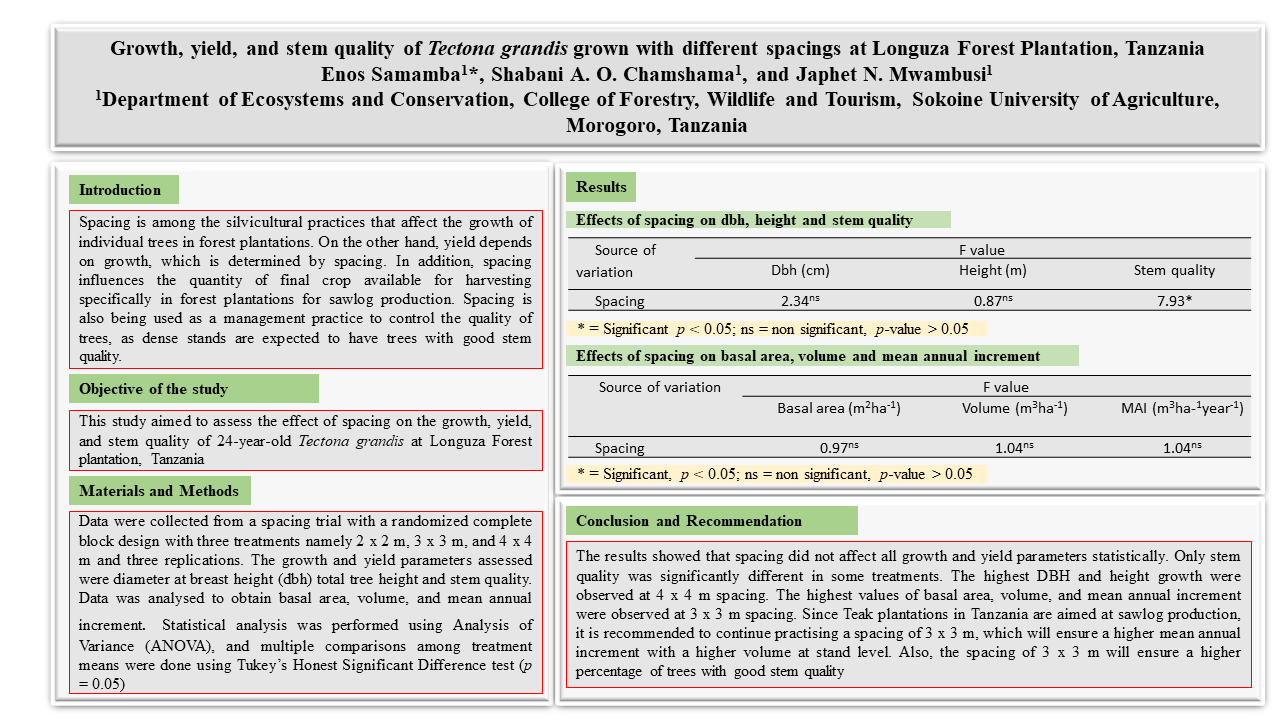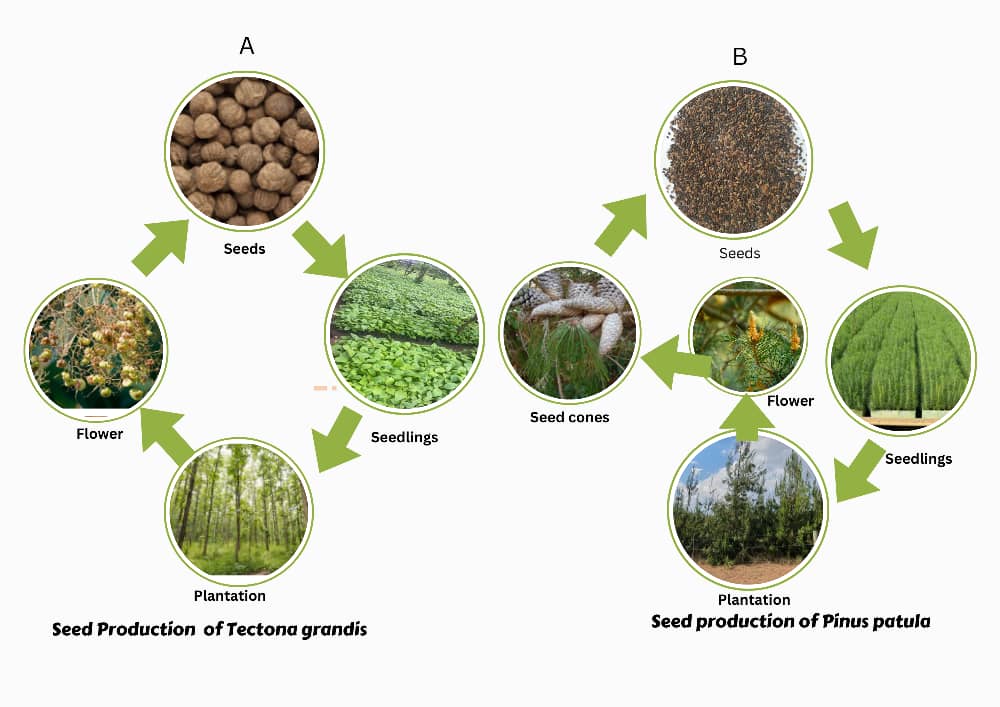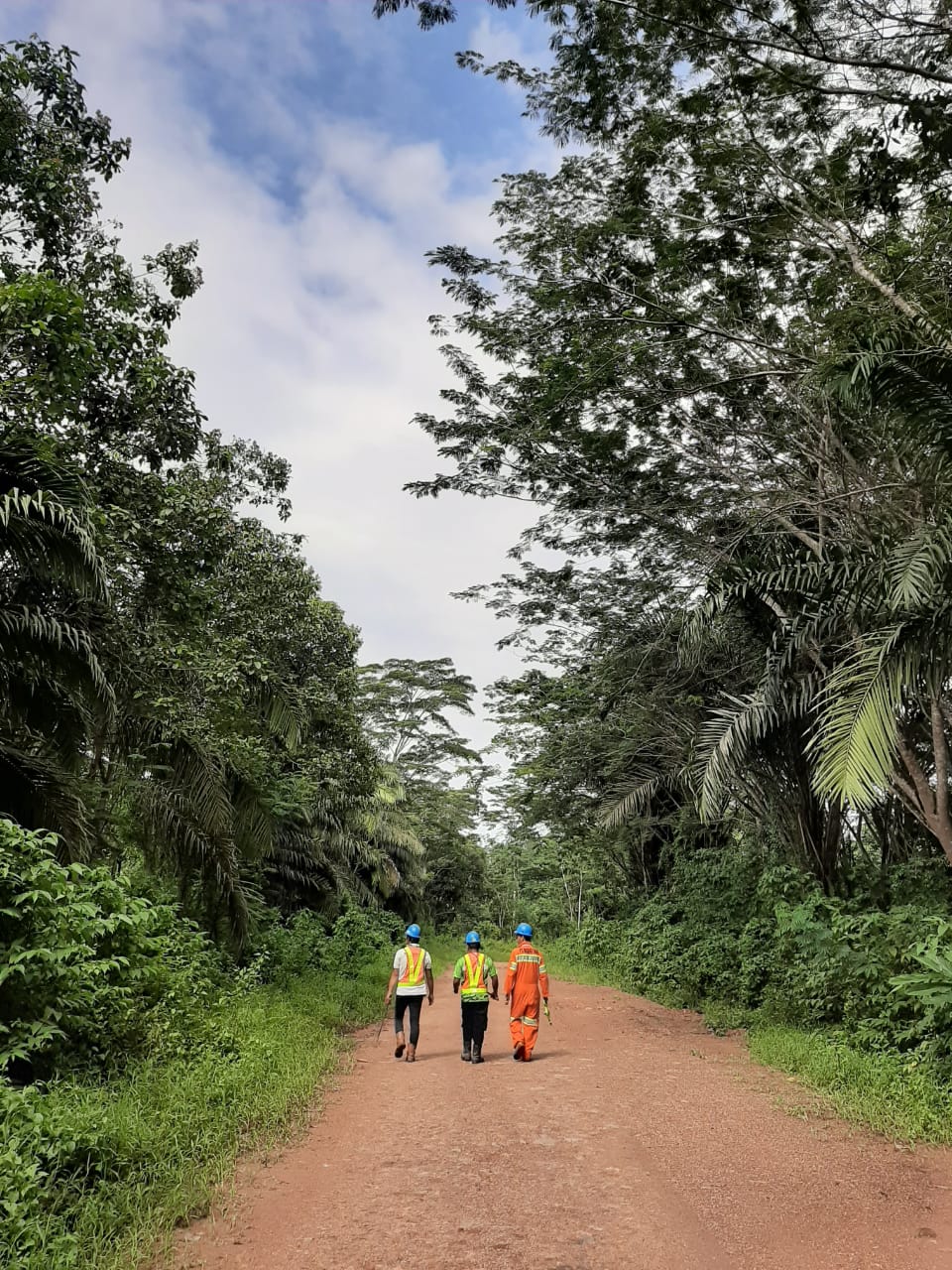Growth, Yield, and Stem Quality of Tectona grandis Grown with Different Spacings at Longuza Forest Plantation, Tanzania
Abstract
Spacing is a silvicultural practice that affects the growth of trees in forest plantations. However, the yield depends on growth, which is determined by spacing. In addition, spacing influences the quantity of the final crop available for harvesting, specifically in forest plantations for sawlog production. Spacing is also used as a management practice to control the quality of trees, as dense stands are expected to have trees with good stem quality. However, little has been done to address the effects of spacing on the growth, yield, and stem quality of Tectona grandis until final harvesting age. Teak plantations in Tanzania are grown at a rotation age of 20 years. Thus, this study aimed to assess the effect of spacing on the growth, yield, and stem quality of 24-year-old T. grandis in a Longuza Forest plantation in Muheza, Tanzania. Data were collected from a spacing trial using a randomized complete block design with three treatments: 2 m × 2 m, 3 × 3 m, and 4 m × 4 m, with three replications. The growth and yield parameters assessed were diameter at breast height (dbh) total tree height, and stem quality. Data were analyzed to obtain the basal area, volume, and mean annual increment. Statistical analysis was performed using analysis of variance (ANOVA), and multiple comparisons among treatment means were performed using Tukey's honest significant difference test (p-value = 0.05). The results showed that spacing did not significantly affect growth and yield parameters. The stem quality was significantly different in some treatments. The highest dbh and height growth were observed at 4 m× 4 m spacing. The highest values of basal area, volume, and mean annual increment were observed at a 3 m× 3 m spacing. Stem quality differed significantly between the 2 m× 2 m and 4 m× 4 m spacings. Because teak plantations in Tanzania are aimed at sawlog production, it is recommended to continue practising a spacing of 3 m× 3 m, which will ensure a higher mean annual increment with a higher volume at the stand level. In addition, a spacing of 3 m × 3 m ensured a higher percentage of trees with good stem quality.
References
Adegbehin, J. O. (1982). Preliminary results of the effects of spacing on the growth and yield of Tectona grandis Linn. F. Indian Forester, 108, 423–430.
Bermejo, I., Canellas, I., & San Miguel, A. (2004). Growth and yield models for teak plantations in Costa Rica. Forest Ecology and Management, 189(1–3), 97–110. https://doi.org/10.1016/j.foreco.2003.07.031
Cardoso, D. J., Lacerda, A. E. B., Rosot, M. A. D., Garrastazú, M. C., & Lima, R. T. (2013). Influence of spacing regimes on the development of loblolly pine (Pinus taeda L.) in Southern Brazil. Forest Ecology and Management, 310, 761–769. https://doi.org/10.1016/j.foreco.2013.09.021
Chamshama, S. A. O., Mugasha, A. G., & Wate, P. A. (1999). Variation in performance of Eucalyptus tereticornis provenances at Michafutene, Mozambique. Silvae Genetica, 48(6), 261–266.
Glencross, K., Nichols, J. D., Grant, J. C., Sethy, M., & Smith, R. G. B. (2012). Spacing affects stem form, early growth and branching in young whitewood (Endospermum medullosum) plantations in Vanuatu. International Forestry Review, 14(4), 442–451. https://doi.org/10.1505/146554812804715865
Gumadi, J., Mwambusi, J. N., Chamshama, S. A. O., Andrew, S. M., & Malimbwi, R. E. (2023). Thinning compliance and its effects on growth, yield and stem quality of Tectona grandis at Mtibwa Forest Plantation, Morogoro, Tanzania. Tanzania Journal of Forestry and Nature Conservation, 92(1), 82–95.
Haninec, P., Madera, P., Smola, M., Habrova, H., Šenfeldr, M., Úradnícek, L., Rajnoch, M., ich Pavliš, J., Cafourek, J., & Novosadova, K. (2016). Assessment of teak production characteristics using 1 m spacing in a plantation in Nicaragua. Bois & Forets des Tropiques, 330, 37–47. https://doi.org/10.19182/bft2016.330.a31317
Iddi, S., Chamshama, S. A. O., & Malimbwi, R. E. (1996). Planting spacing in forest plantation: A review. Forest Record 63. Repository Sokoine University of Agriculture.
Kainyande, A., Kamara, A., & Mattia, S. B. (2023). Spacing effects on the growth and carbon storage of plantation-grown trees in the Njala University tree-spacing experimental plots, Southern Sierra Leone. In C. C. Chang (Ed.), Emerging Issues in Agricultural Sciences Volume 1 (pp. 139–148). BP International. https://doi.org/10.9734/bpi/eias/v1/9626F
Kamara, E. G., Duwaiman, F., Mattia, S. B., Kassoh, F. A., & Conteh, A. R. (2020). Effect of spacing regimes on growth and carbon storage of Tectona grandis, Gmelina arborea and Terminalia ivorensis in a nine-year-old forest plantation in the transition rainforest of Sierra Leone. International Journal of Sciences, 9(3), 5–12. https://doi.org/10.18483/ijSci.2270
Kollert, W., & Cherubini, L. (2012). Teak resources and market assessment 2010. (FAO Planted Forests and Trees Working Paper FP/47/E). Rome, Italy.
Kollert, W., & Kleine, M. (2017). The global teak study. Analysis, evaluation and future potential of teak resources. IUFRO World Series, 36.
Madoffe, S. S., & Maghembe, J. A. (1988). Performance of teak (Tectona grandis L. f.) provenances seventeen years after planting at Longuza, Tanzania. Silvae Genetica, 37, 5–6.
Malimbwi, R. E., Mugasha, A. G., Chamshama, S. A. O., & Zahabu, E. (1998). Volume tables for Tectona grandis at Mtibwa and Longuza forest plantations, Tanzania. Forest Record 71. Repository Sokoine University of Agriculture.
Medeiros, R. A., Paiva, H. N. de, D’Ávila, F. S., & Leite, H. G. (2018). Growth and yield of teak stands at different spacing. Pesquisa Agropecuária Brasileira, 53, 1109–1118. https://doi.org/10.1590/S0100-204X2018001000004
Ngaga, Y. M. (2011). Forest plantations and woodlots in Tanzania (African Forest Forum Working Paper).
Nocetti, M., Rozenberg, P., Chaix, G., & Macchioni, N. (2011). Provenance effect on the ring structure of teak (Tectona grandis Lf) wood by X-ray microdensitometry. Annals of Forest Science, 68, 1375–1383. https://doi.org/10.1007/s13595-011-0145-4
Ola-Adams, B. A. (1990). Influence of spacing on growth and yield of Tectona grandis Linn. F.(teak) and Terminalia superba Engl. & Diels (afara). Journal of Tropical Forest Science, 2(3), 180–186.
Palanisamy, K., Gireesan, K., Nagarajan, V., & Hegde, M. (2009). Selection and clonal multiplication of superior trees of teak (Tectona grandis) and preliminary evaluation of clones. Journal of Tropical Forest Science, 21, 168–174.
Pérez, D., & Kanninen, M. (2005). Effect of thinning on stem form and wood characteristics of teak (Tectona grandis) in a humid tropical site in Costa Rica. Silva Fennica, 39(2), 385. https://doi.org/10.14214/sf.385
Rahmawati, R. B., Hardiwinoto, S., Amin, Y., & Hasanusi, H. (2021). Space planting, competition, and productivity of a seven-year-old clonal teak plantation in the East Java monsoon forest area. Jurnal Manajemen Hutan Tropika, 27(2), 123–123. https://doi.org/10.7226/jtfm.27.2.123
Rahmawati, R. B., Widiyatno, W., Hardiwinoto, S., Budiadi, B., Nugroho, W. D., Wibowo, A., & Rodiana, D. (2022). Effect of spacing on growth, carbon sequestration, and wood quality of 8-year-old clonal teak plantation for sustainable forest teak management in Java monsoon forest, Indonesia. Biodiversitas, 23(8), 41804188. https://doi.org/10.13057/biodiv/d230840
Robertson, R. M., & Reilly, D. F. (2004, October 1921). Performance of a 16-year-old stand of teak (Tectona grandis L) in the Darwin area in relation to that in other trials in the Northern Territory [Paper presentation]. Workshop Prospects for High-value Hardwood Timber Plantations in the “Dry” Tropics of Northern Australia, Mareeba, North Queensland, Australia.
Vigulu, V., Blumfield, T. J., Reverchon, F., Hosseini Bai, S., & Xu, Z. (2019). Growth and yield of 5-year-old teak and flueggea in single and mixed species forestry systems in the Solomon Islands. New Forests, 50, 629–642. https://doi.org/10.1007/s11056-018-9684-y
Zahabu, E., Raphael, T., Chamshama, S. A. O., Iddi, S., & Malimbwi, R. E. (2015). Effect of spacing regimes on growth, yield, and wood properties of Tectona grandis at Longuza Forest Plantation, Tanzania. International Journal of Forestry Research, 2015, 469760. https://doi.org/10.1155/2015/469760
Zanin, D. K. (2005). Feasibility of teak production for smallholders in Eastern Panama [thesis]. Forestry Michigan Technological University.
Authors

This work is licensed under a Creative Commons Attribution 4.0 International License.
Jurnal Manajemen Hutan Tropika is an open access journal which means that all contents is freely available without charge to the user or his/her institution. Users are allowed to read, download, copy, distribute, print, search, or link to the full texts of the articles in this journal without asking prior permission from the publisher or the author. This is in accordance with the Budapest Open Access Initiative (BOAI) definition of open access.






